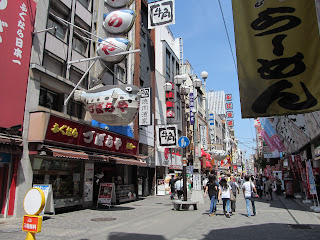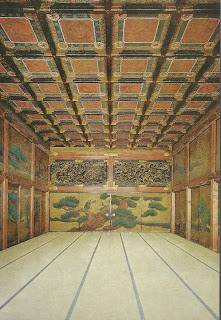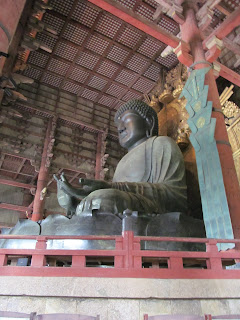We rode the "Bullet
Train" from Tokyo to Osaka. We traveled for quite a while through Tokyo
and then the area became only slightly less urban. Most of the structures were
so unexceptional that it would have been difficult to know you were traveling
in Japan from them. The train wasn't as smooth as the TGV, but it was
comfortable; the seats reclined and there were adjustable, padded footrests.
Shortly before 10:50, we saw Mt. Fuji and
made some photos through the window. Manufacturing plants became smaller and
more interspersed with agriculture. Rice farming in all stages lined the
railway.
We walked through the Dotonbori Shopping District in Osaka.
Osaka
Castle was a stronghold
of the shoguns in the 1600s and rebuilt several times. Some of the stones used
in building the walls reminded us of those used by the Incas because they were
so large. We learned its history and climbed steps and rode an elevator to the
top of the main tower reconstructed in 1931.
Kyoto served as Japan's capital before Tokyo. We went there to see the various temples. We found a modern city around the temples. Some of them seem crowded by their modern neighbors.
Ryoanji
Temple’s (Temple of the Peaceful Dragon) highlight here is a Zen Garden
and we enjoyed the peacefulness of the site. The name comes from the depiction
of a dragon on sliding screens within the pavilion.
Kinahahuji
Temple (The Golden Pavilion) was the residence of Shogunh Ashikaga
Yoshimitsu which was converted to a Zen temple after his death in 1408. The
pavilion, reflected in a lake, is a 1950s reconstruction and is covered with
gold leaf; it is crowned by a phoenix. One of the interesting things was a tree
which began as a bonsai but was planted in the ground after the Shogun's death;
it is trimmed into the shape of a boat.
Kyoto
Shosuikaku Nishijin-Ori Museum of Art, which was in a business which weaves obis. We saw examples
of their work and the threads they use in their weaving; they use very fine
thread to prevent the obi from being too heavy. Some are so finely woven that
the faces of the figures are detailed. In addition to examples of Van Gogh's
works converted to textile, the highlight was a room with a textile version of
Monet's Waterlillies from
"L'Orangerie" in Paris---complete with light show. We were totally
amazed at the quality of the work.
Ginkakuji
Temple (The Silver Pavilion) has a garden designed to be appreciated by moonlight; there
was a raked garden and a Mt. Fuji of sand.
Nijo
Castle originally
built in 1603 for the Tokugawa Shogunate contains large rooms decorated with
beautifully painted shoji screens and carved wooden transoms. Some of the rooms
contain mannequins to show events that occurred there. In the public areas the
floors squeak to alert of the shogun of anyone's approach; they are called
"nightingale floors" but whether they actually sound like birds is
questionable.
From there we made a brief
stop in the Gion area to see the
shrine where Geishas pray. We saw two bridal couples having photo session and
walked across a small bridge over a canal and down a narrow street.
Todaiji
Temple, home
to the world's largest bronze Buddha statue, (Daibutsu) is located in Nara
Park. Because a deer showed the shogun where to build the temple, deer are
considered messengers of the god and roam freely. We found the temple
impressive and the statue's size amazing.
Kasuga
Taisha Shrine
is famous for the thousands of stone lanterns donated by worshipers. There were
also hundreds of hanging brass lanterns; each lantern---stone or brass---has an
inscription with the date and donor's name. A wedding was in progress during
our visit to the shrine and we also saw two babies brought to the shrine for
their "One Hundred Day Blessing;" the paternal grandmother carries
and holds the baby which also gets a red dot on the forehead.
Gekkeikan
Okura Sake Museum contained
dioramas and exhibits explained how Fushimi
Sake is made; samples were offered after the tour.
At Fushima-Inari
Shrine, the huge orange torii gate
at the entrance was visible from a distance. We entered the Shinto shrine and
saw more and more torii gates. As we gradually made our way up the mountain we
stopped at various shrines often walking through a walkway of torii gates. Each
wooden gate is painted orange with the donor's name and the date incised into
the wood and painted black. There are thousands of these gates in about 5
sizes; a chart showed the amount of donation required for each size---from
about $2000 to around $20,000. The 4 km path continues up the mountainside and
makes a circle. At one point there was a small altar containing two stones; the
worshipper prayed and then tried to lift one of the stones. If the stone felt
heavier than expected then the prayer was denied; it it felt lighter, then the
prayer was granted. We watched as a lady prayed and then lifted each stone.
This is another one of those shrines where the worshipper claps twice before
praying "in case the god is sleeping."
The approach to Kiyomizadera
Temple (Pure Water Temple) is up a steep and winding pathway because the
temple is built on a mountainside. Known as the Higashiyama District, walking along this area was a treat. Some
shops sell food; others sell souvenirs; some sell fine pottery and other wares.
Once we arrived at the temple compound entrance, we paid admission and got to
see the famous Stage of Kiyomizadera which
rests on long wooden pillars and a framework assembled without nails as is the
main building of the temple. "Jumping of the stage of Kiyomizadera"
is a Japanese expression used when making a big decision. We had a good view of
the Koyasu Pagoda but did not visit
it; a visit there brings a fortunate childbirth. Near the bottom, we saw Otowa, the water pouring from the
mountainside in three streams running from bamboo pipes. People drink from the
water; one stream brings longevity; a second brings success in school while a
third brings a fortunate love life. Drinking from all three is considered
greedy.

We saw a small shrine with a
Buddha made from a tree killed by the Fukishima tsunami; people pray here for
the victims of that disaster.
Sanjusangendo
Temple is
famous for its one thousand statues of Buddha housed in Japan's longest wooden
building. The wooden Buddhas are aligned
in multiple rows; various stages of peeling gilt adorned them. In front of the
Buddha statues were other statues of important gods and immortals. At the end
of the array, a large serene-looking statue of Buddha provided a focus for
worship and a priest was chanting in front of it. Behind the array of statues
were placards which contained explanations and some depictions of what the
building and statues looked like when newly painted/gilded. Almost all the
information signs had both Japanese and English. Photography was forbidden
inside the temple, so we bought a few post cards.
Another ride on the bullet train took us back to Tokyo to catch the flight to Indonesia.








































.JPG)
.JPG)


.JPG)
.JPG)
.JPG)
.JPG)
.JPG)
.JPG)
.JPG)
.JPG)
.JPG)
.JPG)
.JPG)
.JPG)
.JPG)
.JPG)








.JPG)
.JPG)
.JPG)
.JPG)
.JPG)
.JPG)
.JPG)
.JPG)
.JPG)
.JPG)
.JPG)
.JPG)
.JPG)
.JPG)



.JPG)